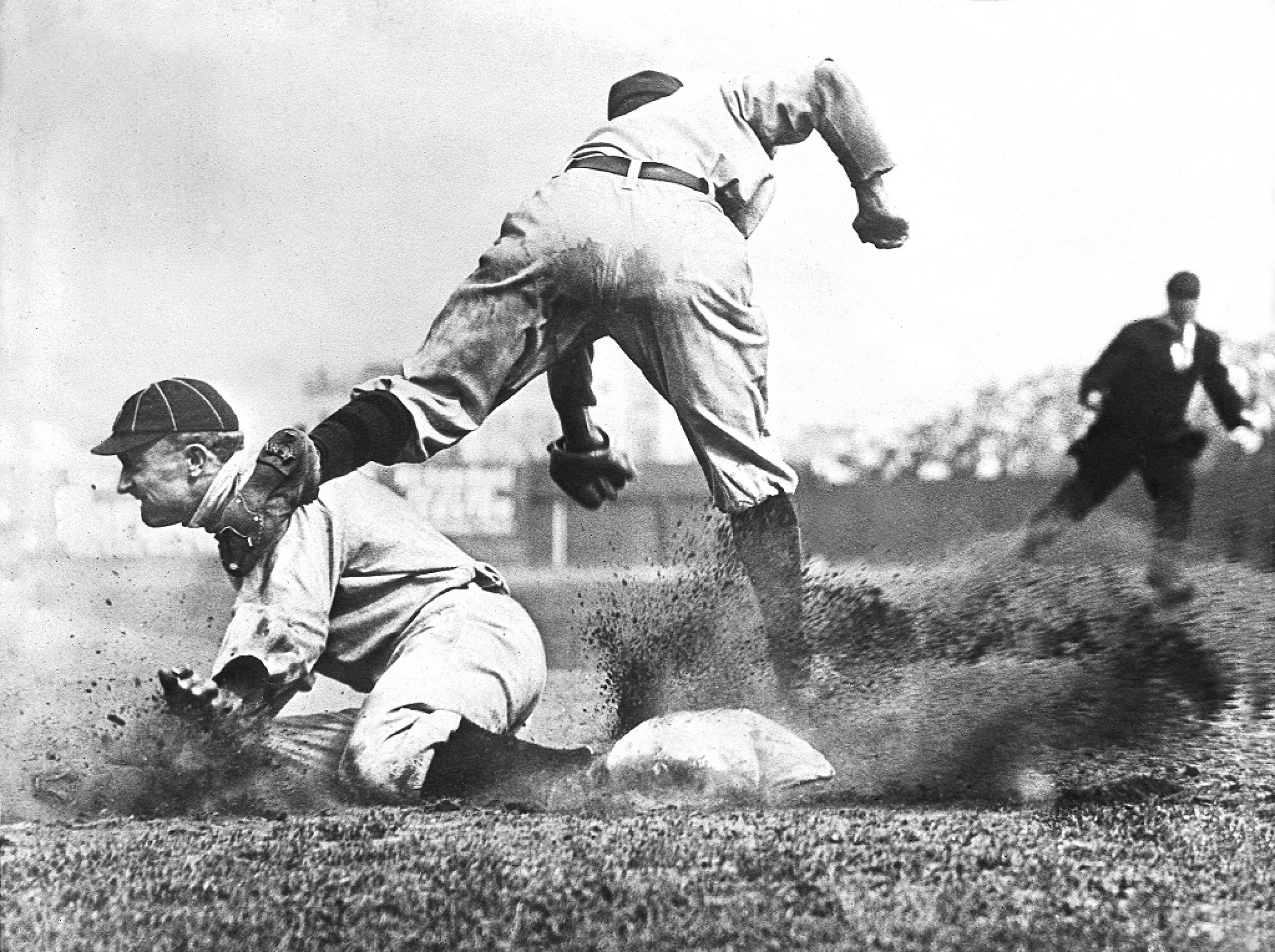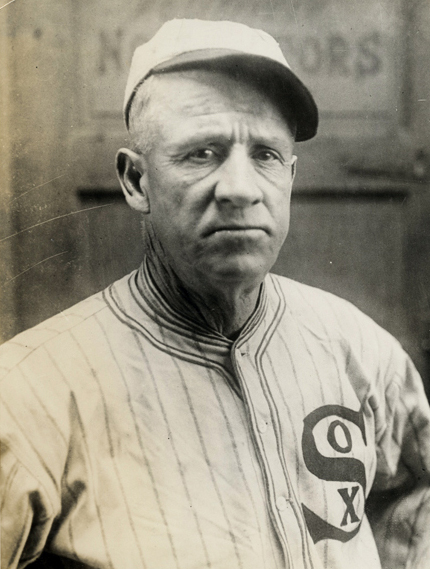Baseball History Comes Alive Now Ranked #2 by Feedspot Among All Internet Baseball History Websites and Blogs!
Guest Submissions from Our Readers Always Welcome!
Subscribe to Old Baseball Photos and Essays for automatic updates (sign-up block found in right side-bar)
As a Free Bonus for subscribing, you’ll get instant access to my two Special Reports: Memorable World Series Moments and Gary’s Handy Dandy World Series Reference Guide!
Kid Gleason Photo Gallery
Click on any image below to see photos in full size and to start Photo Gallery:
Focus on the 1919 Black Sox: Manager Kid Gleason
As the 100th anniversary of the 1919 World Series approaches, we’ll continue our in-depth look at the players and events surrounding baseball’s darkest hour. Today, we examine the career of White Sox manager, William “Kid” Gleason.
“Kid Gleason was, without doubt, the gamest and most spirited ball player I ever saw and that doesn’t except Ty Cobb…He could lick his weight in wildcats and would prove it at the drop of a hat.”- John McGraw”
“The 1919 White Sox are the best team in the world, they have no weaknesses!” –Manager Kid Gleason
There was a lot more to Kid Gleason’s career than just the Black Sox Scandal. He was a scrappy, gutsy little ballplayer who started out as a pitcher and later became the starting second baseman for one of the greatest teams in baseball history, the famous Baltimore Orioles of the 1890s. Always an asset to any team he was associated with, by the time of his death in 1933, he was one of the most beloved figures in the game.
The Camden, New Jersey native acquired the nickname “Kid” early in life because of his short stature (5’7”, 160 pounds as an adult), and his youthful, spirited nature. Over his long, 22-year major league career (1888-1908, 1912), he played for the Phillies, Browns, Orioles, Giants, and White Sox.
In eight seasons as a pitcher, Kid went 138-131 with a 3.79 ERA. Amidst the turmoil caused by the Players League competition in 1890, Kid compiled an unbelievable season: 38-17 (.691), over 506 innings, 2.63 ERA, and 51 complete games. To show what a crazy year it was in baseball, none of these statistics even led the National League! [Ed. Note: Bill Hutchinson pitched 603 innings that year for Chicago!]
His career batting average was a respectable .261 with 1946 hits, 216 doubles, 81 triples, and 824 RBIs. In Kid’s two years with the Orioles (1894 and ’95), he hit a combined .371 with a .404 on-base percentage, as the Orioles won their first two of three straight National League pennants. A true baseball “lifer,” he’s one of the small group of players who have appeared in the major leagues in four decades.
In the featured photo above, we can see that the cares and stresses of the 1919 World Series scandal are deeply woven into the face of Kid Gleason.
After his playing career ended, Gleason became a coach with the White Sox. He was named manager on December 31, 1918, succeeding Pants Rowland. In his first season as manager, Kid led the White Sox to the 1919 pennant with a record of 88-52, but lost to the Cincinnati Reds in the ill-fated 1919 World Series, amidst allegations that the Series had been thrown.
The 1919 White Sox were quite a team, with a roster stacked with star players up and down the lineup, including stars Shoeless Joe Jackson, Buck Weaver, Hap Felsch, Eddie Cicotte, Eddie Collins, Ray Schalk, and Red Faber, the latter three Hall-of-Famers. Acquiring the personality of their manager, they played with the same spark and determination Kid showed during his career, leading the league in runs, batting average, and stolen bases. As is well documented, the scandal resulted in lifetime bans for eight White Sox players. Gleason was not involved, and some historians have noted that he was among those who alerted White Sox owner Charles Comiskey of the fix.
Author Gene Carney, in his acclaimed book, Burying the Black Sox, uncovered evidence that Gleason, aware of the rumors about a fix circulating at the start of the Series, confronted the team. He later told a reporter, “Something was wrong. I didn’t like the betting odds.” Carney added that Gleason said little about the fix for the record later, but that “his communication to his team, especially his ace pitchers, may have resulted in the fix being called off right after his confrontation.”
The White Sox were in a close pennant race again in 1920, but fell out after the eight suspensions came down with three games left in the season. With a roster depleted of its stars, the White Sox went a dismal 208-254 over his last three years at the helm. He finished his managerial career with a 392-364 record.
Kid was out of baseball for two years, but the chance of returning to the game proved to be too much to resist. Connie Mack gave him an opportunity to return to the coaching ranks with the Athletics. Kid was aboard for two World Series championships with the Athletics in 1929 and 1930 and a third pennant in 1931.
Suffering from a heart ailment, Gleason retired after the 1931 season and eventually became bedridden about the time of the 1932 World Series. He passed away on January 2, 1933. Understandably, Kid was said to be personally affected by the Black Sox scandal for the rest of his life, which may have contributed to his early demise at age 66.
That Kid Gleason was one of the most beloved figures in the game was apparent at his funeral, attended by an estimated 5,000 people, including such baseball notables as John McGraw, Connie Mack, and Commissioner Landis.
Let’s take a moment to remember a great baseball “lifer,” Kid Gleason, who, because of the 1919 Black Sox scandal, became one of the game’s most tragic figures.
Gary Livacari
Photo Credits: All from Google search
Check out my two books, both now available on Amazon in e-book and paperback: “Paul Pryor in His Own Words: The Life and TImes of a 20-Year Major League Umpire”and “Memorable World Series Moments.” All profits go to the Illinois Veterans FoundationCheck out my book, “Memorable World Series Moments,” now available on Amazon in e-book and paperback. All profits go to the Illinois Veterans Foundation: https://www.amazon.com/Memorable-World-Moments-Garys-Reference-ebook/dp/B077L85D7C/ref=sr_1_1?ie=UTF8&qid=1547650967&sr=8-1&keywords=Memorable+World+Series+moments
We are a participant in the Amazon Services LLC Associates Program, an affiliate advertising program designed to provide a means for us to earn fees by linking to Amazon.com and affiliated sites. Click here to view Amazon’s privacy policyhttps://www.facebook.com/Don-Stokes-Old-Time-Baseball-Colorizations-923346241033


The lead photo is from 1919, as the White Sox home uniform of that year had this unique trim. Actually, 1919 White Sox had one glaring weakness, particularly in the World Series. Starting pitching depth. Because Red Faber was sidelined, White Sox had only three starting pitchers – Cicotte, Williams, Kerr. Kerr was a well-travelled “rookie”. Remainder of pitching staff was very mediocre. Reds had a much deeper starting staff and reds actually won more games in 1919 season. Final point, if you see 1919 team pictures you see that Kerr, Williams, and Cicotte are all tiny by today’s standards. Each about 5’9”. Bill James at 6’4” towers over them, yet 6’4” is about average for pitchers today.